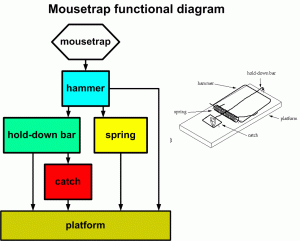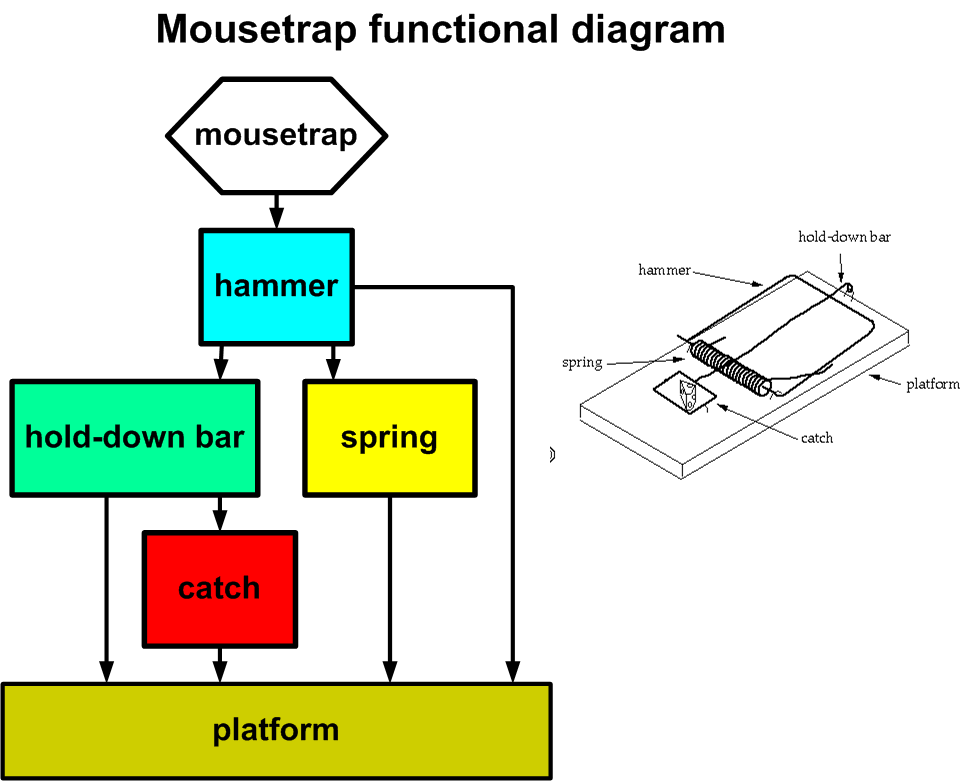 In a comment attached to a previous post of mine (Darwinism from an informatics point of view) I wrote that “to create functioning hierarchical decision logic is a vertical job that only intelligence can do”. In that post, I provided some reasons why it is impossible for a blind evolutionary process to create new instructions. There are of course many additional reasons, over and above those I listed in my post. One of the most important of these is based on the general concept of a functional hierarchy (FH), which is what I intend to blog about today. This post can be considered as a sequel to my previous post on informatics.
In a comment attached to a previous post of mine (Darwinism from an informatics point of view) I wrote that “to create functioning hierarchical decision logic is a vertical job that only intelligence can do”. In that post, I provided some reasons why it is impossible for a blind evolutionary process to create new instructions. There are of course many additional reasons, over and above those I listed in my post. One of the most important of these is based on the general concept of a functional hierarchy (FH), which is what I intend to blog about today. This post can be considered as a sequel to my previous post on informatics.
The threshold of complexity
It is a simple fact that when systems exceed a certain threshold of complexity, their structure will inevitably be that of a multi-level FH. This is not just true for natural systems and machines; nearly everything in modern civilization (including civil, military, commercial and industrial organizations) is hierarchical. Some of the more important hallmarks of intelligence, including natural languages, artificial languages (such as those used in computer programming), science and technology, are all based on hierarchical paradigms. Take a book, for instance. The chapters of the book are composed of paragraphs, which are composed of sentences, which are composed of words (the choice of which is constrained by the requirements of grammar, syntax and logic), which in turn are composed of syllables, which are composed of sounds. At all levels of this hierarchy, each and every component plays an important functional role in conveying the ideas that were originally conceived in the mind of the book’s author, before he decided to put pencil to paper. Likewise, the design of engineering systems requires a hierarchical functional structure. It is this architecture that can create a uniquely organized system out of a multiplicity of diverse functions.
The universe as FH
With FH, we are confronted a general truth, which arises from a kind of technical constraint or necessity, which is situated at the very root of reality. The Great Designer (Who is Unity), when He was designing the cosmos (which is organized multiplicity), understood perfectly well that the main tools for organizing multiplicity – or making order out of chaos – are rules/laws and a hierarchy. Rules/laws are instructions, and superimposing a hierarchy on them means, from an informatics point of view, establishing some sort of software architecture, i.e. a stack of software layers. The initial “Fiat lux” that created “ordo ab chaos” was both a command for creating order, and an order to illuminate everything that lay below. The connection between the English words “command” and “order,” which also holds in other languages, is a profoundly meaningful one.
But why can’t Unity govern multiplicity in a “flat” way, without the aid of any hierarchy, using just two layers – a top and a bottom one, representing a principle and its consequences, or the First Cause and its effects? I have stipulated two layers, because without at least two distinct levels, there can be no manifestation of any kind. Duality is the pre-requisite of multiplicity (a point which is easy to grasp if we think of the number series).
Pythagoras’ Tetraktys
Pythagoras would have answered this question as follows: Unity rules multiplicity by means of hierarchy, because the passage from Unity to multiplicity necessarily implies the existence of intermediate principles, as the series of numbers, generated from the number one, shows. To illustrate this concept, the Pythagoreans used the symbol of the sacred Tetraktys, the numeric formula, 1 + 2 + 3 + 4 = 10. From Unity (symbolized by the number one) to manifestation (symbolized by the number ten) we need to pass through a duality, a triad and finally a quarternity of principles. The related geometric figure used by the Pythagoreans was a triangle with its apex pointing upwards (the universal symbol of hierarchy), composed of a single dot, with two dots underneath it, followed by a row of three dots and a row of four dots at the bottom (see the picture above). Inside this triangle was inscribed the “all-seeing eye”, which is a traditional symbol of God, the Great Designer.
Participation to Unity
Conversely, if we go in the bottom-up direction, we can see that hierarchy is what allows multiplicity to participate in Unity, which is no small thing. Not only does hierarchy serve to command, but it also enables us mere mortals to infer the existence of a Higher Reality. Additionally, it gives every being in the cosmos its own special place, as a significant part of a larger whole. Thanks to the cosmological hierarchy, nothing in the cosmos is completely detached from Unity. From atoms to galaxies, from cells to organisms (which in a sense are organized “galaxies” of cells), the Great Designer shows us the signs of His design, which He has applied to the “hardware” and “software” of His cosmos. Human engineering, which can be regarded an inferior imitation of what the Supreme Designer has already made, betrays similar tell-tale signs of its man-made design.
FH diagrams
The Tetraktys is a kind of prototype or symbolic scheme for any tree graph representing a FH, if we think of its dots as being connected by arrows going from each “parent” dot to its “child” dots. In any field of engineering, similar block diagrams are used on a routine basis to represent functional hierarchies. An FH diagram is a diagram that shows all the functions of a system in a hierarchical manner, like an organizational chart. It specifies the parent function (the function at the very top) and the sub-functions or child functions underneath it. Each child function can then be broken down into further sub-functions.
Organisms as examples of functional hierarchies
Organisms are spectacular examples of functional hierarchies. They are composed of cells, tissues and organs, and at all levels these systems are capable of accomplishing complex inter-related functionalities. Before I continue, I’d like to clear up a misunderstanding which may arise here, due to the fact that we always see organisms growing and developing from something very small, into something much larger. It is certainly true that living things are built from the bottom up (in terms of their development); however, their design is from the top down, generating a perfect tree of functionalities. In general, construction is from the bottom up, while design is top-down. This is just as true for systems in the natural world as it is for systems in engineering.
Hierarchical genes
One of the tenets of the neo-Darwinian theory of evolution is that random mutations in genomes, combined with natural selection, are capable of creating biological novelties, which will eventually give rise to new organs and body plants, and thus generate new functional hierarchies. In genomes, we can observe that genes are organized in a hierarchy of functions, where higher-level genes can switch lower-level genes on and off. Evolutionists also assert that the complexity of these genetic systems does not simply depend on the number of genes, but rather on the intricacy of their relations and references – i.e. their functional inter-connections. This would certainly explain why higher organisms don’t have many more genes than lower organisms. But what do these genes entail for FH? Can the blind process of evolution create a functional hierarchy?
Evolution cannot create FH
The answer I would give to the above question is: no. The reason why blind evolution is unable to create a functional hierarchy is grounded in the fundamental nature of a functional hierarchy. In hierarchical systems, a sub-function exists only because the parent function needs and calls it. The parent function in turn exists only because a higher-level function requires it, and so on all the way up. At the top level is the concept of the system as a whole, which the designer originally conceives in his mind. Thus in a complex system, a functional hierarchy is simply incapable of being generated from the bottom. It has to begin at the top, with a complete view of what the final system will be (teleology). Unfortunately for Darwinism, random mutations and natural selection work only at the bottom level, and are devoid of the teleology required to create something for future use (foresight). Aside from the fact that their “work” mainly consists in damaging genomes willy-nilly and then sifting between the different kinds of damage generated, the unique overarching viewpoint necessary to create a functional hierarchy is completely missing at the bottom level. Unguided evolution is incapable of creating a functional hierarchy, because this type of hierarchy implies the existence of higher-level functions that are capable of guiding subsidiary functions, all the way down to the bottom. But how can a non-driver drive?
FH and teleology
We can look at this issue from another point of view, related to the problem of the blindness of the evolutionary process. Let us suspend our disbelief for the moment, and imagine that unguided evolution somehow managed to overcome all obstacles and create a biological function. Notwithstanding this awesome feat, evolution is still utterly unaware of the fact that this function is capable of serving a higher-level parent function. But even if we suppose that evolution eventually managed to create both of these functions, it would still be incapable of understanding that one of them was capable of serving the other. In short: evolution has no concept of FH. Evolution is one-dimensional, whereas FH is multi-dimensional. Evolution is horizontal, while FH is vertical. Given these built-in limitations, we can see why evolution cannot generate even a minimal functional tree. Whatever functions evolution manages to create will remain isolated or detached, and will never be able to constitute a system, let alone a system with a functional hierarchy. In other words, unguided evolution cannot create FH, because such a system cannot be constructed on a jerry-built basis. A functional hierarchy needs to be conceived as a whole, before any construction can begin. We are once again led to the conclusion we arrived at earlier: FH and teleology are tightly linked.
FH as an indicator of Intelligent Design
After having ruled out blind evolution, we may conclude that FH is indeed at the very core of design. Intelligent design is precisely what gives a system organization, meaning functionality, information and integration – in other words, organic unity. From this unity, we can generate an inverted tree of functionalities, which are virtually contained within it. Thus FH is one of the best indicators of intelligent design, precisely because it focuses on the most important feature of ID: its top-down teleological nature, which is inseparably linked to the unity and organization which intelligent design is capable of creating. Unity creates hierarchy, and conversely, hierarchy conserves and manifests unity.
Biological self-replication implies FH
The information processing required for an organism to reproduce itself (such as that contained in the DNA of organisms’ cells) implies FH, because it is composed (in its minimal hardware configuration) of a parent function (central control unit) which uses at least four child functions: memory, input, output and a universal constructor. Thus DNA and its cellular control machinery instantiate the general concept of a functional hierarchy.
The FH in DNA is a very powerful argument for intelligent design. The main problem with an ID argument from the existence of functional hierarchies in nature, however, is that it presupposes a basic knowledge of engineering, which makes it more difficult for a layman to understand.
Relation between CSI and FH
What is the relationship between the ID concept of Complex Specified Information (CSI) and FH? Bill Dembski writes:
“Biological specification always denotes function. An organism is a functional system comprising many functional subsystems. The functionality of organisms can be cashed out in any number of ways.” (Intelligent Design, 5.7).
Of course, this is true for any specification in general. A function can be considered as a black box which accepts certain inputs from the caller and generates some outputs, using private data. However, one still needs to specify in detail how this black box is able to generate the outputs from the inputs. Without this specification, the function remains undefined. In computer programming terminology, the function must be not only declared, but also implemented. An empty function does nothing. To “flesh out” the function, i.e. explain how the outputs can be derived from the inputs, constitutes specification. Since there is a very strong relation between specification and function, this is an additional reason why a functional hierarchy, which entails the existence of a large number of functions, necessarily implies CSI.
The relation between IC and FH
What are the relations between the ID concept of Irreducible Complexity (IC) and FH? System parts and system components imply the existence of corresponding functionalities, and IC inferences can be applied to functions, as well as components. Viewed in this way, IC can be seen as an inference regarding the minimal functionality of a system.
In the case where a software sub-routine can be eliminated with no adverse consequences for the working of the main system, then it can be described as a dormant function, which doesn’t belong to the IC kernel of the system. This situation often occurs when a software program calls large libraries of functions.
FH diagram of a mousetrap
Although a mousetrap is a very simple mechanical device, we can still view it from an FH perspective. The following figure shows an FH diagram of the functions of a mousetrap (which, as Professor Mike Behe demonstrated in his book, “Darwin’s Black Box,” is a five-component IC system):

The reasoning behind the above diagram goes something like this. Let’s say we want to implement the idea of a mousetrap. What do we need? We can catch mice by many different means (a gun, some poison, some glue, a cat, and so on). However in choosing to build a mousetrap, we have opted for a hammer as our basic “weapon”. This will be the first, or primary, function of our mousetrap project. The position of the hammer at the top is justified by its proximity to our goal of catching mice (symbolized by the hexagonal block at the top). The hammer in turn requires two sub-functions: a spring and a hold-down-bar, which in turn requires a catch. Additionally, the hammer, hold-down-bar, the spring and the catch all share a common sub-function: a platform. It should be noted that the spring is what provides the power for our mousetrap; the hold-down-bar is what provides the control of that power (in this case, a simple on/off control); and the catch is what triggers the control when the mouse’s movements input a signal to the system. Thus we can see that the humble mousetrap instantiates two basic features of system theory: power and control.
Conclusion
Now let’s consider randomness and laws at work. Suppose that these bottom-level processes somehow manage to create a platform for a mousetrap, or some other component. Now what? Because these processes lack foresight, they have no concept whatsoever of any long-term goal, such as a mousetrap. To reach a goal is difficult enough for an intelligence that knows what it wants; how much more so for unguided processes that don’t even know what they want to generate! How could they possibly create the higher functions in the FH of the mousetrap if they are incapable of wanting to catch mice? They simply cannot. Since Darwinian processes are entirely based on random changes and laws, they are unable to create a FH. To sum up: on top of its relation to ID theory, FH involves an additional specific ID inference of its own. Even if we overlook the CSI that it contains, as well as its IC kernel, we can still show that a system with a functional hierarchy needs to be intelligently designed, simply on the basis of the reasoning outlined above: chance and necessity cannot create a FH from the bottom up, because a FH system has to be created from the top down, starting from the abstract level which only an intelligent being can conceive of, and then descending to the material plane.
